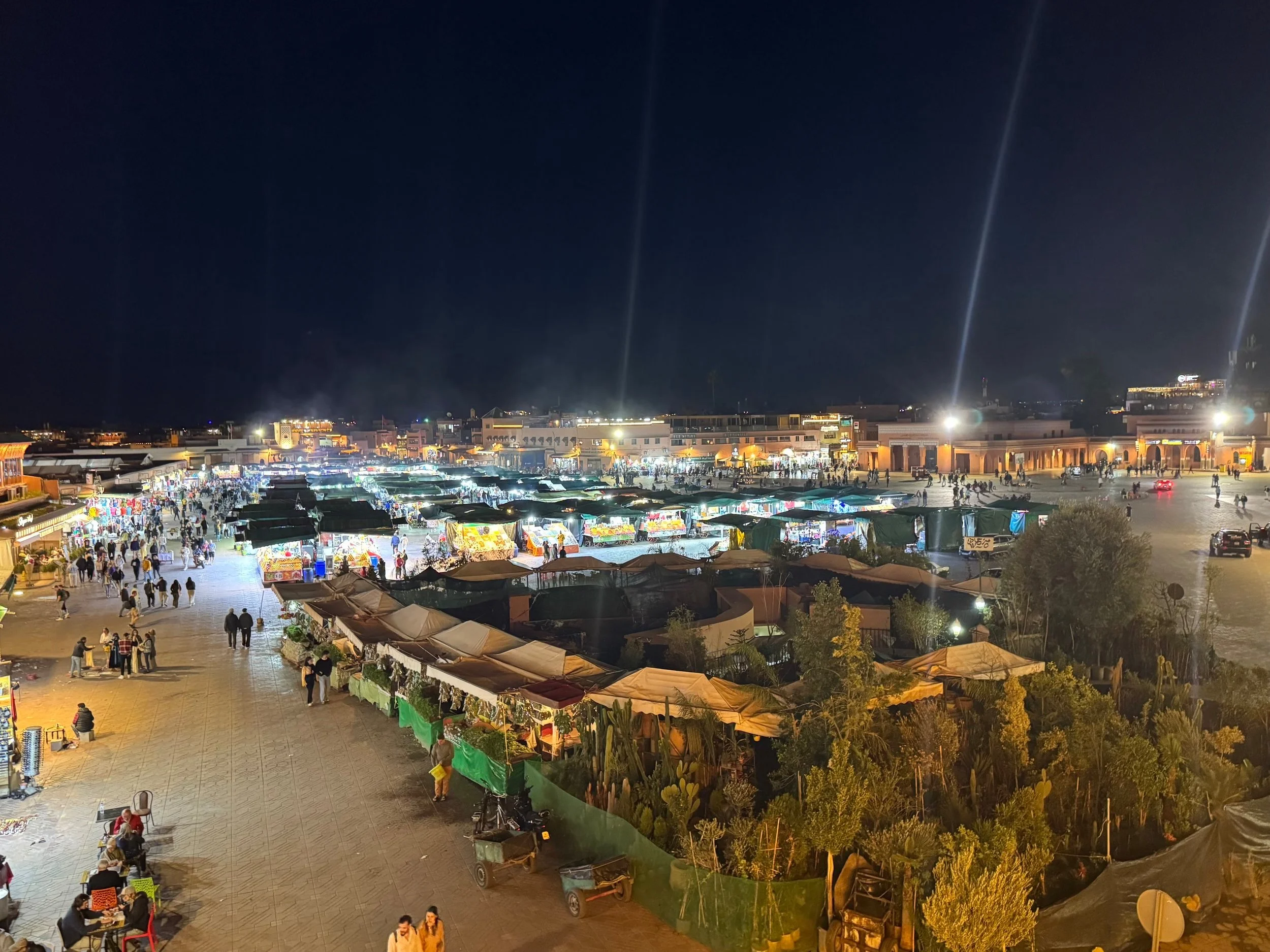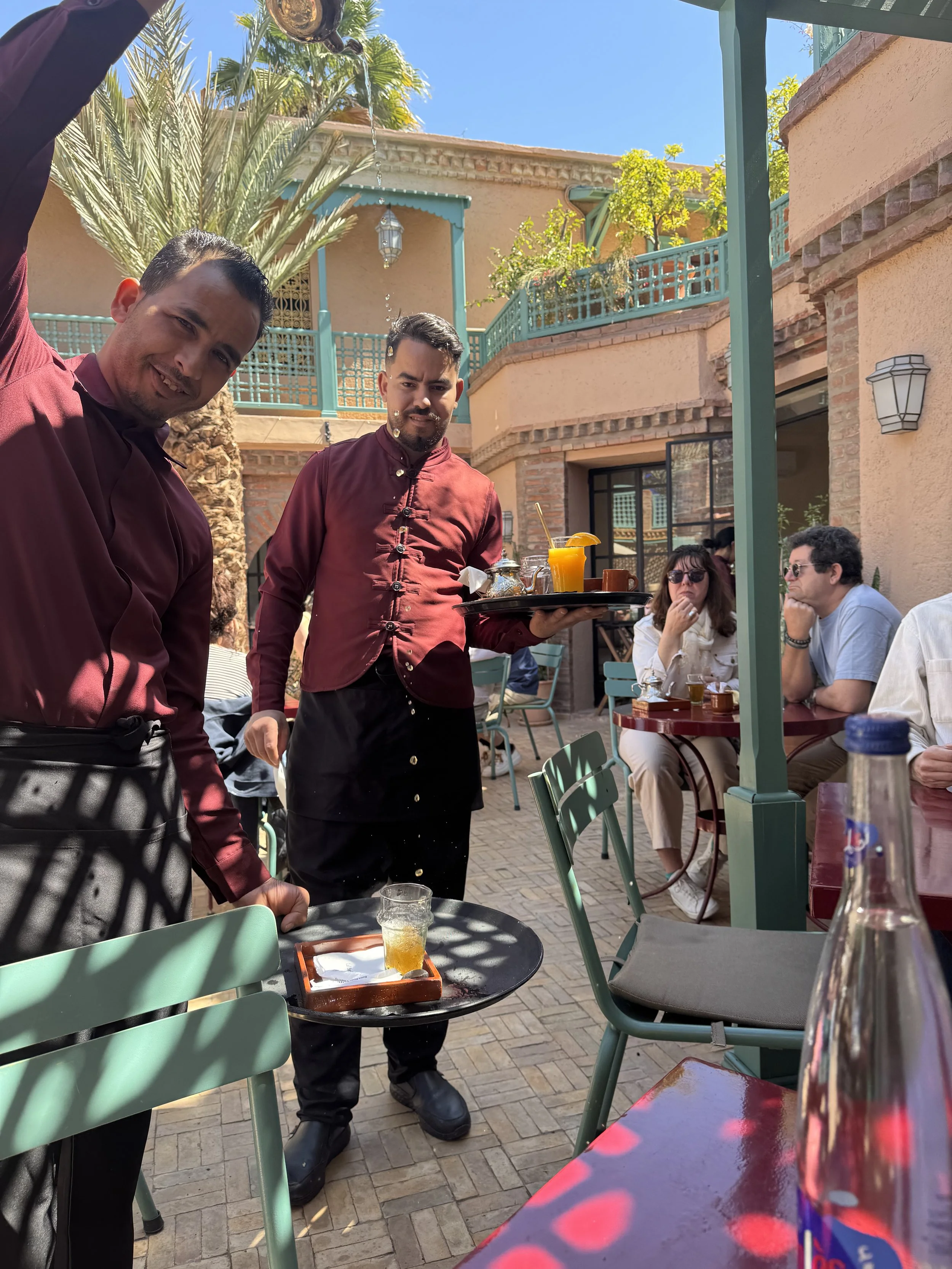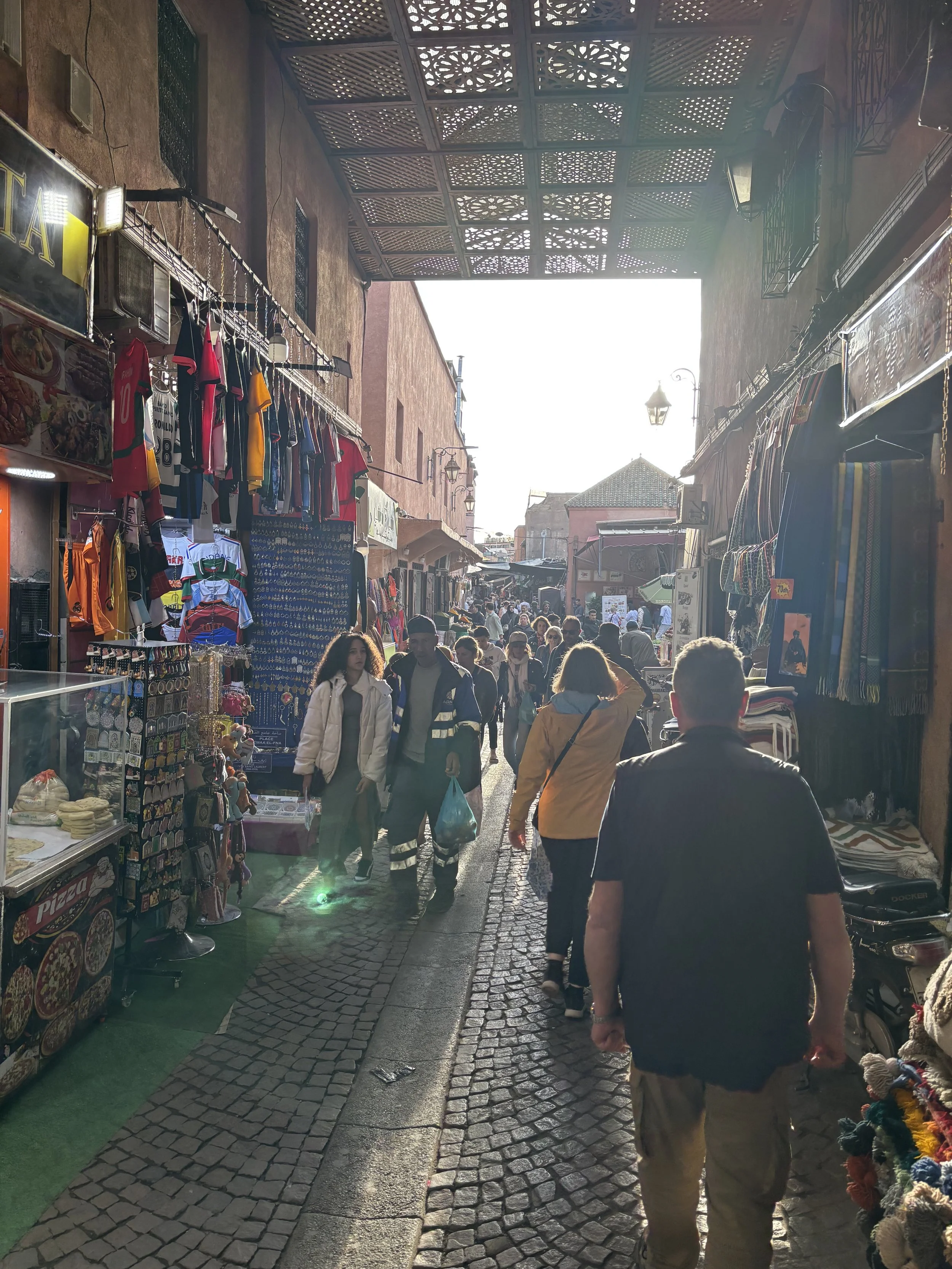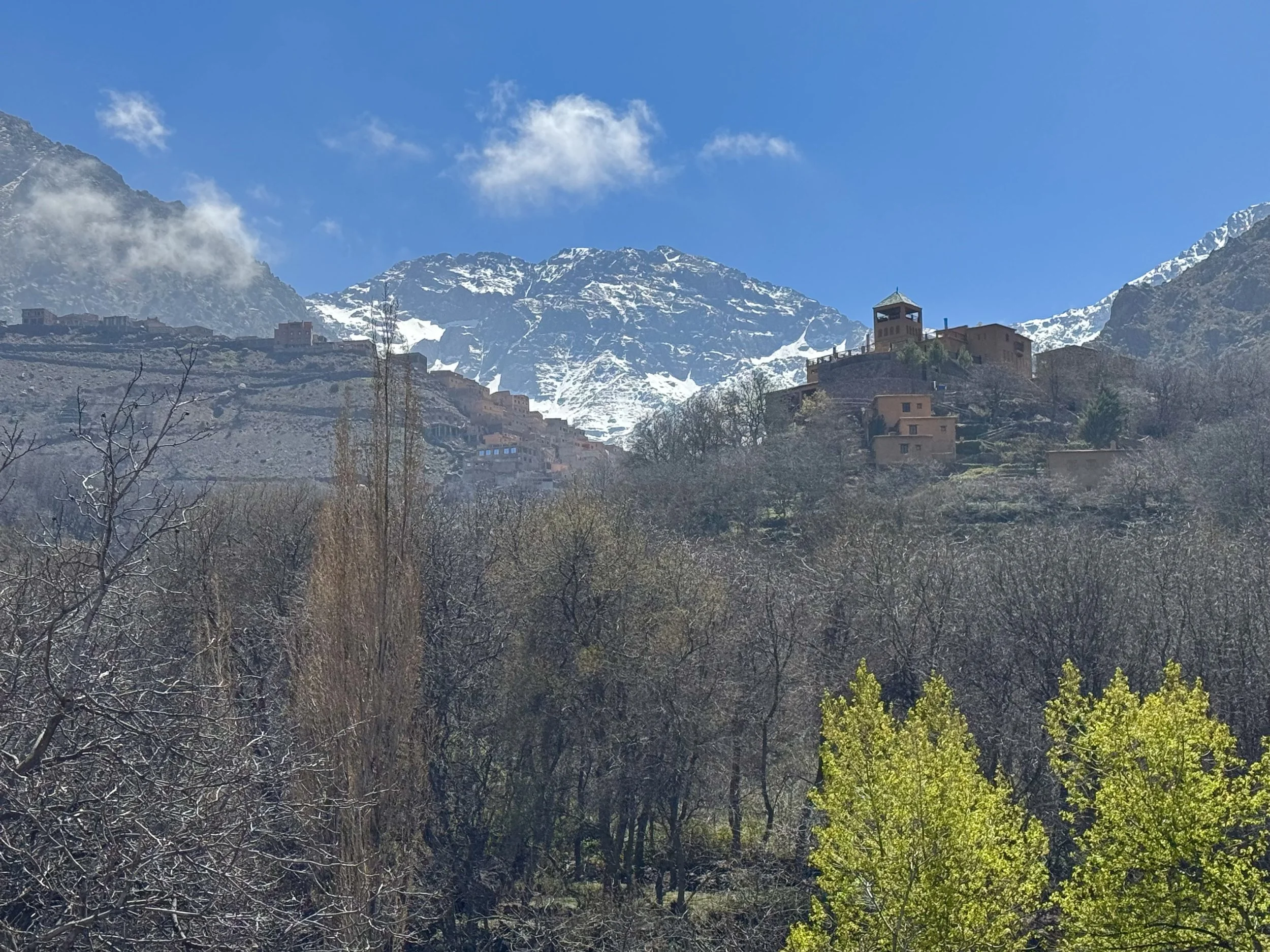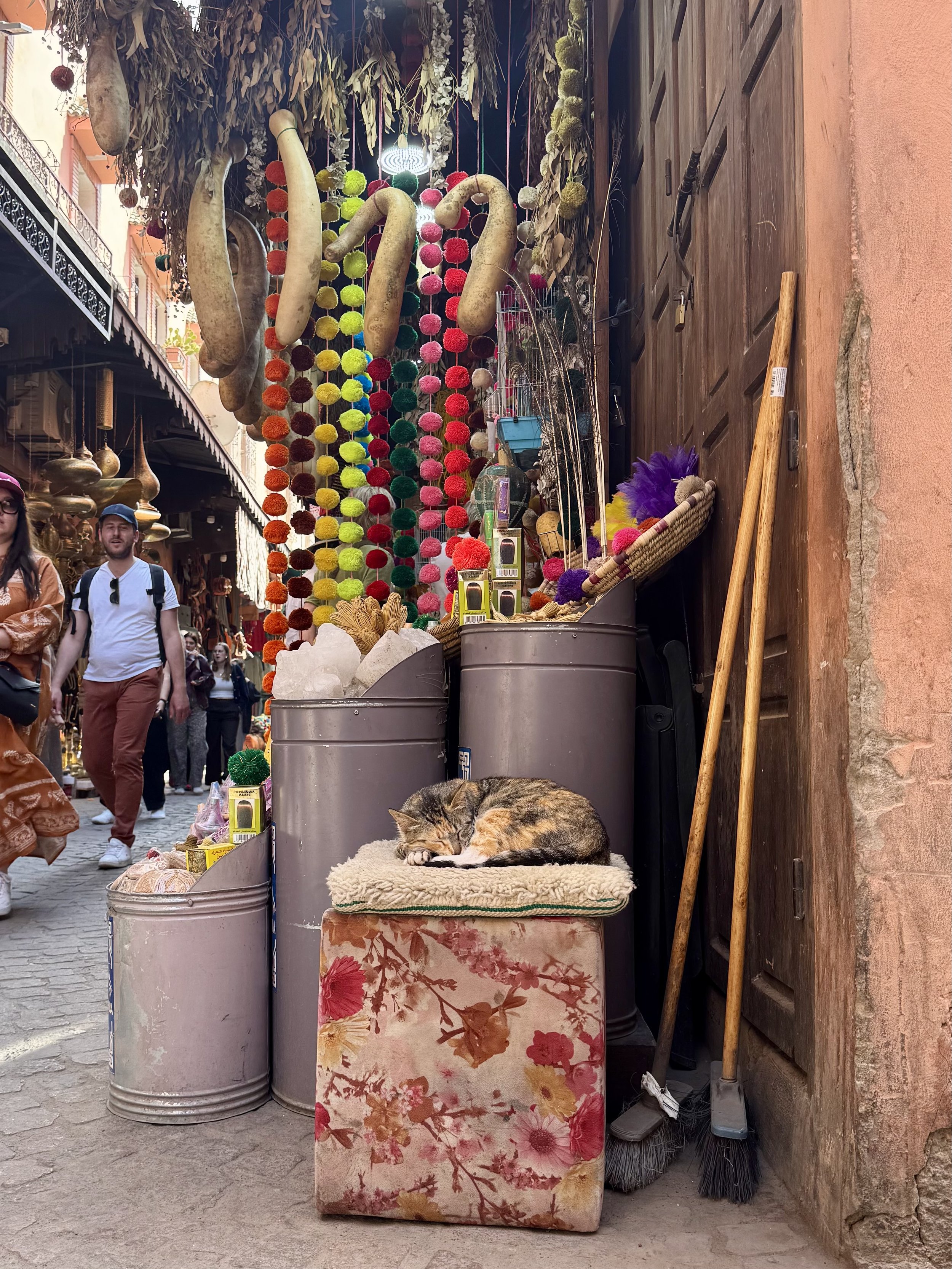So you’re going to Marrakech?
Lucky you!
The Medina at night
My sister-in-law and I take one international trip per year. Morocco has been on our shortlist for a long time, but security concerns (and global pandemic) kept us away until 2025. Now, we are already talking about a return. The food was great, the shopping was a blast, and the sensory experience was immersive. More than anything, we will remember the hospitality of our hosts, who told us, “Welcome to Morocco. This is your second home.” Here are some takeaways, in case you’re contemplating a trip.
Why Marrakech?
The name Marrakech evokes images of exotic spices, colorful textiles, delicious foods, and serious history. Locals pronounce it “Marrrr-AH-ksh”, which I loved. It is nicknamed the ‘Red City’ for its ubiquitous ochre-colored architecture. The city’s eleventh-century Medina is recognized as a UNESCO World Heritage Site, which it calls ‘an outstanding example of a living historic town with its tangle of lanes, its houses, souks, fondouks, artisanal activities and traditional trades’.[1] What’s not to like?
Where to Stay
We chose a riad (via AirBnb), located inside the old city walls a short walk from Jemaa El Fnaa square. A riad is a traditional Moroccan house with a central courtyard. Apparently, most riads come with a housekeeper/cook who makes breakfast every morning. We came to love our hostess, a home-cooked meal to start off our day, and the chance to talk to a local. (We communicated using a mix of English, French, Arabic, hand signals, translation apps, and laughs).
The Internet was unreliable, an odor of sewage haunted parts of the house, the kitchen was probably not meant for guests to use, and while our beds were clean and comfortable, I’d caution travelers to prepare for a different level of cleanliness, fit-and-finish, and modern conveniences than you might expect in Helsinki or Los Angeles.
All in all, staying in a riad felt authentic and fun. I recommend it over a hotel if you don’t mind a little inconvenience in the spirit of adventure.
When to Go
Our visit coincided with the holy month of Ramadan, during which observant adult Muslims fast from dawn to dusk—meaning no food, no water, and no ‘bodily delights’ such as smoking or sex. I expected short tempers and bleary eyes, but in fact, we were treated with graciousness and patience. In fact, acts of charity and kindness are especially encouraged during the month of Ramadan.
That said, we didn’t want to make demands of our hosts and restaurant wait staff when they were hungry and tired. We avoided the sunset hour and tried not to ask anything extra of our housekeeper after noon. In the town of Imlil, outside Marrakech, most eateries were closed. The Medina is livelier at other times of year when entertainers have more energy for dancing, singing, and performing acrobatics. If I could do it again, I wouldn’t go during the holy month.
Food
Mint tea
Consisting of clay pot stews (tajine), French-style pastries, couscous, and salads, the food was uniformly delicious. Fresh mint tea was served up practically every time we sat down. Vegetarians will be challenged, as most dishes are meat-based, and the squeamish will want to look the other way when passing display cases containing goat heads, eyeballs, and freshly butchered meat.
As for street food, we erred on the side of caution when we saw flies and bees on piles of pretty pastries. Local fruit juices are said to be safe, but unless you are at a reputable hotel or restaurant, drink them without ice, which use local tap water.
Breakfast consists of eggs, crepes, croissants, flatbreads, and spreads such as honey, jam, and a wonderful, sweet sesame spread called amlou. Wash it down with fresh juice, coffee and mint tea.
Rooftop at sunset over the Medina: Make a reservation at a rooftop restaurant overlooking the Jemaa El Fna square in the evening. It almost doesn’t matter which restaurant you choose but ask for a table with a view and go in the evening, when the lanterns twinkle, the prayers are called, dancers perform, and the partying gets underway.
Brunch at a fancy hotel: Try a poolside buffet brunch at one of the high-end hotels—El Fenn, La Mamounia, or dinner in a sumptuous garden hotel such as Dar Yacout. Surround yourself with luxury, hobnob with wealthy Moroccan and French tourists. Investigate the prices ahead of time, though: our brunch for two cost more than US$350.
Fun
- Hammam: You won’t want to miss out on this traditional bath and massage treatment. So relaxing and refreshing. Do be prepared to strip down to your birthday suit (women are given disposable panties). We reserved online the 50-minute “Royal Hammam” treatment for about US$25 each. Attendants tossed warm water over our heads, laid us down on heated tables and exfoliated our skin, washed our hair with argan oil shampoo, and sat us down for mint tea in a quiet lounge. The treatment did not include a facial, though, so we wished we had brought some facial moisturizer with us. Hammamdelarose.com
- Henna tattoo: Don’t get one out in the Medina, where cheap dyes may irritate your skin. Pick a reliable place. We went to Henna Art Cafe (no reservation necessary), where we celebrated our new tattoos with a delicious lunch on the terrace.
Shop!
Haggling in the souks is standard, but I was surprised at how little the final sale price budged despite my heartfelt negotiations. For example, if 350 dirhams was the initial offered price, we settled at around 300. I had been told to expect fifty percent cuts from the initial price. The Terraces des Épices is a quiet(er) oasis in the mayhem and has a wonderful patisserie for a break from shopping. The Ensemble Artisanal has a smaller selection, but there is no haggling or high-pressure sales, and the quality is high. (Photo by Genevieve Kocienda)
- Shop: Haggling in the souks is standard, but I was surprised at how little the final sale price budged despite my heartfelt negotiations. For example, if 350 dirhams was the initial offered price, we settled at around 300. I had been told to expect fifty percent cuts from the initial price. The Terraces des Épices is a quiet(er) oasis in the mayhem and has a wonderful patisserie for a break from shopping. The Ensemble Artisanal has a smaller selection, but there is no haggling or high-pressure sales, and the quality is high.
- Tannery: Skip it.
- Le Jardin Marjorelle and YSL Museum: Beautiful gardens, lovingly tended.
- Photography Museum: If you enjoy historical photographs, don’t miss this small museum. We particularly appreciated the film loop, taken in the 1950s or 1960s, chronicling a French adventurer’s travels through the Atlas Mountains and his encounters with the local Berber tribes. We finished with a cup of coffee on the rooftop terrace.
- Cats! They are everywhere. Many of them are hungry or ill, but others are loved and well cared-for. It’s hard not to scoop the stray ones up and take them home, but at least you can appreciate them as an integral part of life in Morocco.
- Listen: The call to prayer echoes throughout the city five times a day. It is an invitation to prayer, not a requirement, so stores stay open, cars keep moving, and restaurants continue serving food, yet a respectful hush falls while the call is underway. At night and before dawn, the chanting woke me from sleep, lovely and moving.
- Venture into the Atlas Mountains: We spent our last night in Imlil, a Berber town of donkeys and unpaved roads in the foothills of the Atlas Mountains. Imlil is the launch point for hikers taking on the snow-covered peak of Jebel Toubkal. After dusty, noisy Marrakech, the bracing mountain air and the music of alpine streams was a thrill. Wandering the streets was uncomfortable, as everyone wanted to sell us something, but our hotel (Dar Imlil) was fabulous. It was warm (heated rooms!), comfortable, and afforded jaw-dropping views. The gracious staff served us a fireside dinner and delicious breakfast the next morning. If we had it to do over again, we would arrange for a guide to take us on a day hike into the mountains. We were so glad we included Imlil in our plans.
In Imlil, looking toward Jebel Toubkal, the tallest peak in Northern Africa
What to Pack
Mid-March was cool, requiring sweaters and jackets in the evenings and mornings. The rooms in our riad were mostly open to the courtyard air, so it got chilly in the evenings. By mid-day we shed our jackets and dug out sunglasses, sunscreen, and sun hats. I brought sandals but didn’t wear them because the souks and streets are so dusty and heavily trafficked that close-toed shoes are your best bet. Be modest and respectful in your dress—this is not the place for yoga pants, cleavage, or bare shoulders.
Our AirBnB lacked shampoo and a washing machine, so bring soaps.
Cybersecurity can be a problem. We purchased Nord VPN (downloadable) and installed it on our digital devices.
Get Around
Money: Morocco is a cash economy, so stock up on dirhams, especially small bills and change. We only used our credit cards at the big hotels. Tips are appreciated, even in euros or dollars.
Guides: We hired a certified guide for our first day in the souks. He took us to the Medersa Ben Youssef, an Islamic school, and we learned many interesting facts, but guides aren’t necessary if you prefer to explore on your own.
Transport: We walked almost everywhere during our week in Marrakech. Our GPS apps took us through the souks and down unexpected side streets, so getting to our destination was half the fun.
- We arranged ahead of time (through our AirBnB) for a driver to/from the Marrakech train station, and another driver to take us to Imlil. Well worth it.
- Trains: Getting from Casablanca to Marrakech and back was easy: we booked tickets online using Rail.Ninja. The trains were on time and safe (although the onboard toilet is literally an opening in the car onto the tracks below) and the stations were organized and clean. We also took a train from the Casablanca airport to the Casablanca rail station—just follow the signs.
Safety: We felt safer than we might have done in a major U.S. city. Maybe that’s because pickpockets face a mandatory five-year jail sentence in Morocco. We learned quickly not to fall for the friendly people who offer to show you something special and then hand you off to a friend who hands you off to another friend. Just say no politely and keep walking.
Language: We got around fine with English. You might freshen up your French before going, or learn some basic phrases in Arabic, but it was not necessary.
Morocco was fantastic! We would love to go back—if we do, we’ll check out Fez and the “Blue City” Chefchaouen. What did I forget? What did I get wrong? Tell me in the comments!
This cat is clearly loved.
[1] https://whc.unesco.org/en/list/331/

